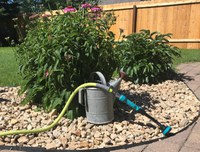Dakota Gardener: The Art and Science of Watering Your Plants
(Click an image below to view a high-resolution image that can be downloaded)
By Esther McGinnis, Horticulturist
NDSU Extension
A fatal mystery exists.
In the middle of a severe and lengthy drought, garden centers report that customers are returning large numbers of dead plants. Closer inspection reveals that the cause of death is drowning. How is that possible during a drought?
Facing sustained high temperatures and the lack of rainfall, gardeners may overreact by watering in excess. Walking the fine line between over- and underwatering is possible but requires good technique and a knowledge of plant science.
Gardeners will be surprised to learn that wilting leaves are a classic sign of over- and underwatering. Saturating the soil suffocates the plant because water fills the air spaces in the soil. Consequently, the plant roots are unable to extract the oxygen they need and may succumb to rot fungi. As the roots die, the plant may wilt.
In the absence of rain, plants need approximately 1 to 1.5 inches of irrigation per week. The water can be applied in one or two applications per week, preferably during early morning hours.
Sprinkling a little bit every day is not good for plants because it encourages the development of shallow roots. Watering deeply once a week is better.
An efficient way to water is to use a soaker hose or drip irrigation system because it minimizes evaporation.
If using a sprinkler, watering can be uneven and it can be difficult to tell how much water has been applied. Tuna cans or similar containers can be used as measuring devices. Place cans at various intervals from the sprinkler and then run the water for 15 minutes. You will be able to measure how much water accumulates in each can during that time frame.
To prevent overwatering in the garden, use your finger as a cheap “moisture meter.” Stick your finger 2 inches into the soil. If the top 2 inches are moist, then watering should be postponed.
Sandy soils will dry out faster than fine-textured clay soils. Red River Valley clay soils have a large water-holding capacity and are easier to overwater.
Plants in containers dry out faster than in the ground. A couple of factors contribute to the high water usage. First, tall containers drain faster because of gravity. In addition, containers are filled with a quick-draining potting soil. Container plants may need daily watering during hot, dry weather, particularly if the plants are large.
Avoid completely drying out the potting soil because it will shrink away from the sides of the container. Make sure that containers have drainage holes in the bottom to prevent water from collecting and suffocating the roots.
Raised garden beds also dry out faster than in-ground beds due to gravity and the soil mix that is used. Daily monitoring is advised.
Mulch is very beneficial in preserving soil moisture, cooling the soil and preventing weed germination. A 3-inch layer of wood mulch is recommended around trees and in ornamental beds. In the vegetable garden, organic mulches such as straw or shredded leaves work well. If using straw, make sure that it is free of weed seeds and herbicide residue.
Armed with good watering technique, gardeners will be able to avoid the most common cause of plant mortality.
For more information about gardening, contact your local NDSU Extension agent. Find the Extension office for your county at https://www.ag.ndsu.edu/extension/directory/counties.
NDSU Agriculture Communication - July 20, 2021
Source: Esther McGinnis, 701-231-7971, esther.mcginnis@ndsu.edu
Editor: Ellen Crawford, 701-231-5391, ellen.crawford@ndsu.edu




